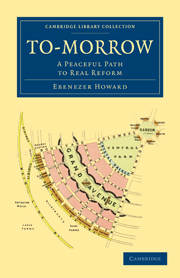Book contents
- Frontmatter
- Contents
- LIST OF ILLUSTRATIONS
- Introduction
- Chap. I The Town-Country Magnet
- Chap. II The Revenue of Garden City, and how it is obtained—The Agricultural Estate
- Chap. III The Revenue of Garden City—Town Estate
- Chap. IV The Revenue of Garden City—General Observations on its Expenditure
- Chap. V Further Details of Expenditure on Garden City
- Chap. VI Administration
- Chap. VII Semi-Municipal Enterprise—Local Option—Temperance Reform
- Chap. VIII Pro-Municipal Work
- Chap. IX Administration—A Bird's Eye View
- Chap. X Some Difficulties Considered
- Chap. XI A Unique Combination of Proposals
- Chap. XII The Path followed up
- Chap. XIII Social Cities
- Chap. XIV The Future of London
- APPENDIX: Water-Supply
- INDEX
- Plate section
Chap. VI - Administration
Published online by Cambridge University Press: 05 February 2012
- Frontmatter
- Contents
- LIST OF ILLUSTRATIONS
- Introduction
- Chap. I The Town-Country Magnet
- Chap. II The Revenue of Garden City, and how it is obtained—The Agricultural Estate
- Chap. III The Revenue of Garden City—Town Estate
- Chap. IV The Revenue of Garden City—General Observations on its Expenditure
- Chap. V Further Details of Expenditure on Garden City
- Chap. VI Administration
- Chap. VII Semi-Municipal Enterprise—Local Option—Temperance Reform
- Chap. VIII Pro-Municipal Work
- Chap. IX Administration—A Bird's Eye View
- Chap. X Some Difficulties Considered
- Chap. XI A Unique Combination of Proposals
- Chap. XII The Path followed up
- Chap. XIII Social Cities
- Chap. XIV The Future of London
- APPENDIX: Water-Supply
- INDEX
- Plate section
Summary
“The present evils of city life are temporary and remediable. The abolition of the slums, and the destruction of their virus, are as feasible as the drainage of a swamp, and the total dissipation of its miasmas. The conditions and circumstances that surround the lives of the masses of the people in modern cities can be so adjusted to their needs as to result in the highest development of the race, in body, in mind and in moral character. The so-called problems of the modern city are but the various phases of the one main question, How can the environment be most perfectly adapted to the welfare of urban populations? And science can meet and answer every one of these problems. The science of the modern city—of the ordering of the common concerns in dense population groups—draws upon many branches of theoretical and practical knowledge. It includes administrative science, statistical science, engineering and technological science, sanitary science, and educational, social and moral science. If one uses the term City Government in the large sense that makes it inclusive of this entire ordering of the general affairs and interests of the community, and, further, if one grasps the idea that the cheerful and rational acceptance of urban life as a great social fact demands that the City Government should proceed to make such urban life conduce positively to the welfare of all the people whose lawful interests bring them together as denizens of great towns, he will understand the point of view from which this book had been written.”
—“Municipal Government in Great Britain,” Albert Shaw (T. Fisher Unwin), Chap, i, p. 3.- Type
- Chapter
- Information
- To-morrowA Peaceful Path to Real Reform, pp. 63 - 71Publisher: Cambridge University PressPrint publication year: 2010First published in: 1898

